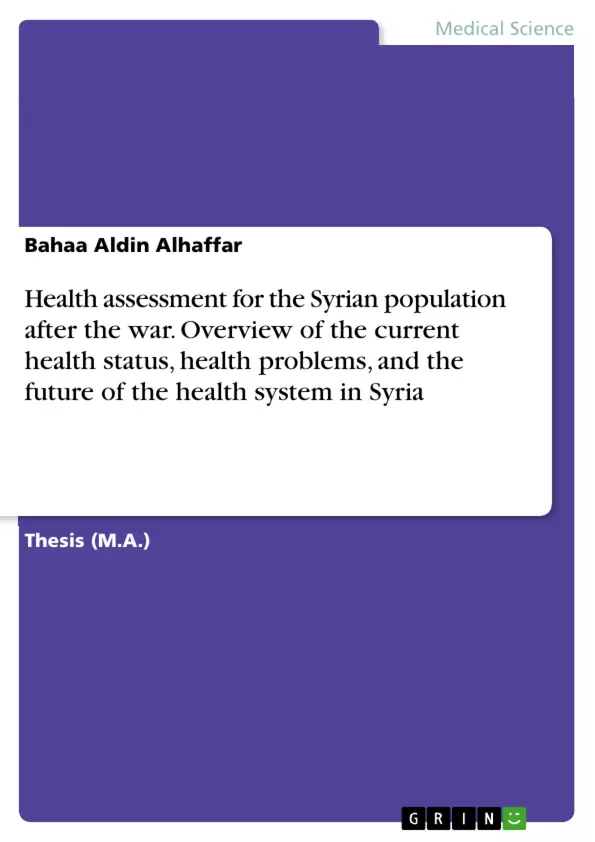
Health assessment for the Syrian population after the war. Overview of the current health status, health problems, and the future of the health system in Syria
Magisterarbeit, 2021
42 Seiten, Note: 95%
Leseprobe
Inhaltsverzeichnis (Table of Contents)
- Introduction:
- Aim of the research:
- Objectives:
- Research questions:
- Methods:
- Search strategy:
- Results of the search:.
- Thematic analysis:
- Syrian health system before the war:.
- Current health status for the population inside Syria: .
- 1- Under opposition control:..
- 2- Under governmental control: .
- Health status for the Syrian refugees:..
- 1- Refugees in Turkey: .
- 2- Refugees in Lebanon:.
- 3- Refugees in Jordan:.
- 4- Refugees in Europe: .
- 5- Refugees in other countries:
- Public health indicators of the Syrian population:...
- 1- Mental health:
- 2- Maternal and children health:
- 3- Oral health:..
- 4- Non-communicable diseases:
- 5- Infectious and communicable diseases: .
- 6- Occupational health and healthcare providers situation:..
- 7- Health system in Syria during COVID-19 pandemic:
- The future of the health system in Syria:.
- Conclusion:.
- Acknowledgments:..
- References:
- The devastating consequences of the Syrian war on public health, including the destruction of infrastructure and the displacement of populations.
- The challenges facing the Syrian health system, such as limited access to healthcare, insufficient resources, and the shortage of healthcare providers.
- The health status of Syrian refugees in various host countries, focusing on the challenges they face in accessing healthcare services.
- The key public health indicators that highlight the Syrian population's health status, such as mental health, maternal and child health, oral health, and non-communicable diseases.
- The need for international support to rebuild the Syrian health system, with a focus on improving access to healthcare for all Syrians.
Zielsetzung und Themenschwerpunkte (Objectives and Key Themes)
This literature review aims to provide a comprehensive overview of the health status of the Syrian population after 10 years of war, examining the impact of the conflict on the Syrian health system and exploring the challenges facing the healthcare system. The review analyzes the current health situation, assesses the remaining health facilities, and identifies the gaps that need to be addressed for the future of the Syrian healthcare system.
Zusammenfassung der Kapitel (Chapter Summaries)
The introduction provides a comprehensive overview of the Syrian war's devastating impact on the Syrian population and infrastructure, highlighting the significant challenges facing the health system. It describes the displacement of populations, the destruction of health facilities, and the shortage of healthcare providers, emphasizing the urgent need for humanitarian assistance.
The review analyzes the current health status of the Syrian population living inside Syria, examining the situation under both governmental and opposition control. It explores the challenges faced by healthcare systems in these regions, highlighting the lack of resources and the mental pressure on healthcare providers.
The review further explores the health status of Syrian refugees in various host countries, including Turkey, Lebanon, Jordan, Europe, and other locations. It delves into the challenges refugees face in accessing healthcare services and highlights the importance of providing adequate support to meet their health needs.
The review examines public health indicators of the Syrian population, including mental health, maternal and child health, oral health, non-communicable diseases, infectious and communicable diseases, occupational health, and the impact of the COVID-19 pandemic on the Syrian health system.
Schlüsselwörter (Keywords)
The main keywords and focus topics of this literature review include the Syrian war, public health, health system, Syrian refugees, health status, access to healthcare, healthcare providers, mental health, maternal and child health, non-communicable diseases, infectious diseases, COVID-19 pandemic, and the rebuilding of the Syrian health system.
Details
- Titel
- Health assessment for the Syrian population after the war. Overview of the current health status, health problems, and the future of the health system in Syria
- Hochschule
- Debreceni Egyetem (public health)
- Veranstaltung
- public health
- Note
- 95%
- Autor
- Bahaa Aldin Alhaffar (Autor:in)
- Erscheinungsjahr
- 2021
- Seiten
- 42
- Katalognummer
- V1176750
- ISBN (Buch)
- 9783346600714
- Sprache
- Englisch
- Schlagworte
- syria syrian crisis public health war conflict crisis refugee
- Produktsicherheit
- GRIN Publishing GmbH
- Preis (Ebook)
- US$ 20,99
- Preis (Book)
- US$ 29,99
- Arbeit zitieren
- Bahaa Aldin Alhaffar (Autor:in), 2021, Health assessment for the Syrian population after the war. Overview of the current health status, health problems, and the future of the health system in Syria, München, Page::Imprint:: GRINVerlagOHG, https://www.diplomarbeiten24.de/document/1176750
- Autor werden
- Ihre Optionen
- Vertriebskanäle
- Premium Services
- Autorenprofil
- Textarten und Formate
- Services für Verlage, Hochschulen, Unternehmen

- © GRIN Publishing GmbH.
- Alle Inhalte urheberrechtlich geschützt. Kopieren und verbreiten untersagt.
- info@grin.com
- AGB
- Open Publishing
Der GRIN Verlag hat sich seit 1998 auf die Veröffentlichung akademischer eBooks und Bücher spezialisiert. Der GRIN Verlag steht damit als erstes Unternehmen für User Generated Quality Content. Die Verlagsseiten GRIN.com, Hausarbeiten.de und Diplomarbeiten24 bieten für Hochschullehrer, Absolventen und Studenten die ideale Plattform, wissenschaftliche Texte wie Hausarbeiten, Referate, Bachelorarbeiten, Masterarbeiten, Diplomarbeiten, Dissertationen und wissenschaftliche Aufsätze einem breiten Publikum zu präsentieren.
Kostenfreie Veröffentlichung: Hausarbeit, Bachelorarbeit, Diplomarbeit, Dissertation, Masterarbeit, Interpretation oder Referat jetzt veröffentlichen!
- GRIN Verlag GmbH
-
- Nymphenburger Str. 86
- 80636
- Munich, Deutschland
- +49 89-550559-0
- +49 89-550559-10
- info@grin.com
-









